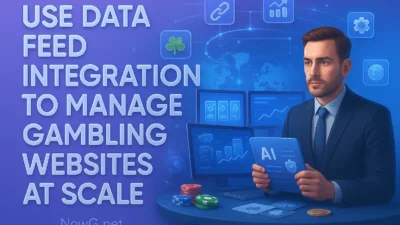Last Updated on October 27, 2025 by Caesar Fikson
Gut feeling is intoxicating. A trader’s hunch on derby day, a CRM manager’s “this bonus always pops,” a creative director’s pet headline. I’ve had those instincts too—and sometimes they even worked.
But here’s the uncomfortable truth I’ve learned the hard way: in iGaming, intuition scales your mistakes as quickly as your wins. Data disciplines the chaos. When you wire your growth engine to hard evidence—clean events, model-driven targeting, controlled experiments—you stop chasing luck and start compounding advantage.
The mindset shift: from campaign-led to system-led
I used to “launch-and-hope”: assemble a tactical calendar, push creative, pray the deposit curve holds. Now I run marketing like a system—inputs, transformations, outputs. Inputs are events and context (page views, bet slip actions, deposits, KYC outcomes, PSP responses, self-exclusion flags). Transformations are models and rules (attribution, fraud scoring, churn risk, LTV forecasts, bonus eligibility). Outputs are decisions (who sees what, when, on which channel, with which cap). Sounds clinical? It’s liberating. A system forgives a bad day; a calendar doesn’t.
And yes, data-driven doesn’t mean “cold.” Players are human; messages still need soul. It just means we stop lying to ourselves about what’s actually working.
iGaming’s data realities (and why ignoring them is expensive)
Three constraints define our playground:
- Regulation and privacy change measurement. Consent regimes, cookie loss, app tracking restrictions, geofencing—if your stack still relies on last-click cookies, your “winners” are probably the loudest channels, not the best.
- Multi-vertical journeys distort attribution. Sports prospects cross over to casino after a tight accumulator loss. Poker grinders dabble in blackjack between tournaments. If you judge channels by first-deposit only, you’ll underfund the ones that unlock cross-sell LTV months later.
- Fraud and bonus abuse blur signal. Bot traffic, device farms, proxy chains, arbitrage on welcome packages—clean data is earned, not assumed. I don’t optimize anything before I trust the inputs.
Here’s the bottom line when you marry the three: your gut can’t adjust for hidden constraints in real time; a data pipeline can.
The measurement spine: events, identity, and truth
I’ve shipped too many “analytics revamps” to still pretend this is glamorous. It’s plumbing. But the spine matters.
Event taxonomy that outlives your roadmap
Start small, name events clearly, and lock properties that answer marketing questions without turning every analysis into a crime scene. My non-negotiables:
- Acquisition:
ad_click,lp_view,reg_start,reg_complete,kyc_submit,kyc_approved,ftd(first-time deposit),psp_decline(with code),bonus_claimed. - Engagement:
sports_bet_placed(stake, odds, sport),casino_spin(game_id, provider, stake),session_start/end,responsible_gaming_event(self-exclusion, limits). - Monetization:
deposit(amount, PSP, instrument),withdrawal_request,net_ggrby vertical. - Lifecycle:
cross_sell_offer_shown/accepted,vip_tier_change,churn_flagged.
Keep property names consistent across web/app/server. A little OCD here saves months later.
Identity that survives channel chaos
You need a durable player key that stitches web cookies, app IDs, and back-office accounts. I run a server-side ID map with deterministic joins first (login, email, phone, KYC), then probabilistic fallback only for analysis—not for payouts or compliance. Have you considered the downstream impact of identity uncertainty on your affiliate invoices? That’s where disputes are born.
Source of truth (and how to keep it)
Warehouse-first is standard now: events stream into a cloud warehouse; dashboards draw from curated marts, not raw chaos. I quarantine suspect traffic, backfill late postbacks, and annotate anomalies (provider outages, PSP downtimes). Annotating isn’t busywork; it’s how your future self stops gaslighting your past self.
Attribution, incrementality, and the myth of the perfect model
Attribution ≠ truth; it’s a model of truth. I rotate between three lenses depending on the decision I need:
- Rules-based (position-based, time decay) when I need stable budgeting fast. Not sexy; very useful.
- Data-driven MTA (logistic/Markov) when I have healthy touchpoint depth and want marginal ROAS by channel or creative cluster.
- Incrementality (geo holdouts, switchback tests) when I suspect halo or cannibalization and need causal lift, not correlation.
Have you considered the downstream impact of switching attribution methods mid-quarter? Agencies will celebrate when their favorite lens returns the crown. I keep a translation sheet that shows how each model treats typical journeys; then I brief stakeholders before any change. It saves drama.
MMM for the grown-ups: when top-down beats click trails
Marketing Mix Modeling (MMM) used to feel academic. Not anymore. In regions where tracking is noisy and brand spend is material, a weekly MMM capturing TV, influencers, affiliates, PPC, sponsorships, and seasonality gives you the macro pulse that click trails can’t. I don’t use MMM to price a single keyword; I use it to answer “what if” questions at the portfolio level: if I shift 10% from brand PPC to streaming sponsorships in Q4, how does FTD per net GGR move, given sports calendar effects and casino margins? MMM is your weather forecast; MTA is your umbrella.
Predictive models that pay rent (and the ones that don’t)
I’ve decommissioned more models than I’ve kept. Useful ones share a trait: they change a decision you make daily.
- Churn risk (survival models) drives CRM cadence and offer size. If risk spikes after a specific pattern (two narrow sports losses + low wallet), I send a low-cost engagement nudge, not a blunt bonus bomb.
- LTV at acquisition calibrates CPA ceilings by channel and affiliate. It’s frustrating when a flashy channel with high FTD count actually delivers low 90-day GGR. LTV models end that mirage.
- Cross-sell propensity picks the moment to introduce slots to a sports-first cohort (e.g., post-event lull windows).
- Fraud likelihood gates bonus eligibility and triggers KYC workflows before cash leaves the building.
What usually doesn’t pay rent? Overfit “next-best-game” recommenders without content constraints, or black-box models the team can’t debug. If ops can’t reason about it, they won’t trust it—no matter how good the ROC curve looks.
Affiliate marketing: clean pipes, clean payouts
Affiliate is the bloodstream in iGaming, and data pollution here is expensive. I run three layers:
- Granular postbacks: fire goal events (reg, FTD, deposit milestones, net revenue) with transaction IDs and timestamps so partners see exactly what you see.
- Deduplication and anti-fraud: device fingerprint checks, IP/ASN risk, velocity limits, bonus-abuse heuristics. When risk is high, slow the payout until a human reviews.
- Transparent reconciliation: monthly statements that map every invoice line to warehouse events. When disputes happen (they will), you win with logs.
Here’s where an affiliate platform with real-time attribution, flexible goals, custom commission plans, and built-in fraud logic saves sanity. I’ve used plenty; the ones that win let me customize events, pass macros cleanly, and pivot commissions when LTV reality bites.
CRM that behaves like a trader, not a megaphone
Mass blasts look big; targeted sequences print money. I organize lifecycle into moments and missions:
- Onboarding: get the first deposit, then the first bet/spin quickly. Friction kills intent. I A/B test cashier UX obsessively (PSP ordering, saved methods, decline messaging).
- Activation: convert from “registered but cold” to “active player.” Micro-incentives work better than oversized, leaky bonuses.
- Retention: frequency caps per channel (email/push/SMS/in-app), channel arbitration (don’t triple-ping), and content rotation to combat fatigue.
- Win-back: let models define “cooling vs churn.” I don’t blast a 100% deposit match to zombies; I prefer low-cost re-engagement triggers plus fresh content (new market, derby storyline, tournament).
And please—measure message-level lift. If your push makes players active earlier but lowers net GGR after bonus cost, that’s not a win; that’s a time-shifted liability.
Creative strategy: ideas, but evidence-led
When I evaluate creative I don’t ask “do I like it?” I ask: Does the hook match a player need, does the proof resolve risk, does the ask feel safe?
- Sports: odds storytelling, local derbies, big narratives. Dynamic odds visuals tend to pull; overpromised parlays tend to backfire on ROAS.
- Casino: RTP and volatility are niche; players respond to moments—new provider drops, seasonal events, prize ladder mechanics.
- Compliance: bucketing claims by jurisdiction matters. “Free bets” language can be regulated; your creative matrix should swap copy per GEO at build-time, not in post.
Creative testing is a logbook, not a gallery. I track hook → hold rate → click → FTD → 90-day GGR. If the hook wins views but loses LTV, I retire it. Yes, even if everyone loves it internally.
Payments and decline codes: the silent conversion killer
We romanticize ad winners and forget payments. PSP decline reasons often explain your “mysterious” FTD dips. I segment by instrument (card/e-wallet/bank), PSP, issuer country, and time of day. A “hard decline” storm on one PSP? Reorder options or route intelligently. Also, surface clear error copy at cashier—vague failures tank conversion and flood support, which then slows KYC, which then kills mood. Dominoes.
Bonus economics: from blanket generosity to surgical generosity
Bonuses can buy activity, but only precise bonuses buy margin. I treat every promotion like a futures contract:
- Target: behavioral segment with uplift potential (don’t bribe whales for activity they’d do anyway).
- Trigger: action that’s predictive of longer-term value (2nd deposit, cross-sell attempt).
- Cap: hard ceiling by player and by cohort to avoid runaway liability.
- Clawbacks: transparent, fair, jurisdiction-compliant. Confusing T&Cs poison trust.
Once you simulate net GGR after bonus cost and PSP friction, your “hero offer” will… shrink. That’s healthy.
Responsible gaming as a growth lever (yes, really)
It shocks some teams when I say this, but responsible gaming is a growth feature. Clear limit tools, proactive outreach on risky patterns, and simple self-exclusion flows don’t just satisfy regulators; they build brand trust and shrink future write-offs. I’d rather keep a healthy player for 36 months than juice a fragile one for 3 weeks. Data helps you know the difference.
Experimentation that respects reality
I love A/B tests as much as anyone, but iGaming has seasonality, fixtures, and VIP whales that break naïve tests. Three rules save me:
- Stratified randomization by vertical and value band (new, active, VIP-lite, VIP).
- Calendar awareness (don’t test cashier changes across a Cup final and compare to a quiet week).
- Guardrail metrics beyond conversion (complaints, churn, RG triggers, PSP costs).
And if you’re testing attribution-affecting changes (like new server-side tracking), hold out a control geo where you change nothing. When intuition screams “we broke it,” you’ll have a clean comparator.
Data ops: where most teams quietly lose the war
Data engineering is not a side quest. It’s the marketing engine room.
- Freshness SLAs: CRM can’t trigger same-day win-backs on data that updates tomorrow.
- Schema versioning: marketing loves to add new properties mid-campaign; keep backward compatibility or your dashboards gas out.
- Reverse ETL: models that never reach channels are thought experiments. Pipe predictions into ad platforms, ESPs, push providers—where decisions happen.
- Access control: regulators will ask who saw what. Be ready.
What “good” looks like: my north-star metrics
I don’t run 200 KPIs; I run a few with context:
- FTD to 90-day net GGR by channel/affiliate 🎯
- Deposit approval rate by PSP/instrument/geo 🧾
- Bonus cost as % of net GGR by cohort 🎁
- Churn hazard (week-over-week) by segment 🧊
- Cross-sell penetration (sports → casino; casino → live) 🔁
- Complaint rate per 1,000 active users (by topic) 🧯
- RG interactions (limits set, cooling-off) with retention impact 🧠
These numbers tell me where to dig; the narrative tells me what to change.
Tooling that actually helps (official links in-table only)
| Category | Vendor (official) | Why I use it |
|---|---|---|
| Affiliate tracking & partner ops | Scaleo | Real-time postbacks 🔁, custom goals 🎯, flexible commission plans 💸, anti-fraud 🛡️ |
| Mobile attribution / MMP | Adjust / AppsFlyer / Singular | iOS/Android measurement 📱, SKAN pipelines, fraud suites |
| Web & product analytics | GA4 / Amplitude / Mixpanel | Event analytics 📊, cohorts, funnels |
| Data warehouse | Snowflake / BigQuery | Cheap scale 🧱, SQL for everything |
| BI & reporting | Looker / Tableau / Power BI | Stakeholder dashboards 📈 |
| CDP & reverse ETL | Segment / Hightouch | Clean events in, predictions out 🔄 |
| Messaging (ESP/push/SMS) | Braze / Iterable | Real-time triggers ⏱️, channel arbitration |
| Experimentation | Optimizely / VWO | Holdouts, stats power, guardrails |
| Anti-fraud & risk | SEON / Sift | Device/IP risk 🕵️, velocity checks |
| Product feedback | Hotjar / FullStory | Session insight 🔍, UX tears discovered faster |
No utm tags, just clean homes. Add a ticketing tool and a wiki and you’ve got a stack you can scale without crying.
Playbooks I actually run
Lift CPA ceilings with predictive LTV (the only safe way)
- Train a 90-day LTV model by channel/creative/affiliate.
- Set CPA caps by predicted value, not historical average.
- Review weekly; kill inventory that “looked good” but underdelivers in post.
Cross-sell sports to casino without annoying anyone
- Detect “cooling” after a heartbreaking accumulator loss.
- Show a low-friction side quest (free spins ladder with modest cap).
- Measure net GGR delta over 30 days; cap exposure for chronic loss chasers.
Bonus abuse pressure test
- Launch a modest welcome bundle with velocity checks and device/IP scrutiny.
- Track early withdrawal attempts and PSP declines clustered by affiliate.
- Tighten rules; cut sources that fail a 2-week audit; send reconciliation with logs.
Creative fatigue radar
- Weekly cohort tests with 20% budget on “fresh” hooks.
- Trigger auto-rotation when hold rate drops >15% from baseline.
- Archive losers; annotate “why” for training and future ideation.
Payments first aid
- Surface PSP health in a live widget; auto-reorder cashier options when approval dips.
- Roll error-specific microcopy (not “transaction failed,” but “issuer declined—try [X]”).
- Watch FTD recovery rate; it’s the cheapest “acquisition” you’ll buy.
Channel and attribution sanity check
| Question 🤔 | What I look at | Decision I change |
|---|---|---|
| Are affiliates getting over-credited? | First-deposit vs. 90-day net GGR by source | Commission tiers; cap rules; creative guidelines |
| Is paid social cannibalizing brand search? | Geo holdouts + MMM slope | Shift 10–20% budget; test creator-led ads |
| Are push/SMS blasts profitable? | Net GGR minus bonus and opt-outs per 1,000 sends | Tighten caps; switch to in-app for heavy cohorts |
| Did our cashier “improve” or just move pain? | Decline codes by PSP before/after change | Reorder PSP; update copy; alert support |
Lifecycle messaging guardrails (or how not to spam)
| Moment 🎯 | Allowed channels | Caps | Success signal |
|---|---|---|---|
| Onboarding (D0–D7) | Email, in-app, limited push | 1 email/day; 2 push/week | FTD rate, first bet/spin completion |
| Activation (D8–D21) | Email, push, SMS (opted) | 3 touches/week total | Net GGR uplift vs control |
| Retention (active) | In-app, email | 2 touches/week | Session frequency without bonus overuse |
| Win-back (cold) | Email + one push | 2 touches/month | Reactivation rate net of promo cost |
Common failure modes (I’ve made them all)
- Attribution flip-flopping without stakeholder prep. Suddenly “search is dead” and you nuke revenue. Don’t.
- Opaque bonus math that trades tomorrow for today. If finance can’t reconcile promo cost to GGR at cohort level, you’re flying blind.
- Data latency that bricks real-time CRM. A “win-back” two days late is a goodbye letter.
- One-size-fits-all RG comms. Players have different risk profiles and different thresholds; model that and speak appropriately.
- Affiliate macro chaos. If your links don’t carry clean macros, your postbacks will be riddled with guesswork, and invoicing will become a monthly courtroom drama.
If you remember nothing else
Data-driven marketing isn’t about worshiping dashboards. It’s about better bets: cleaner measurement, calmer attribution, tighter experiments, faster creative cycles, smarter bonuses, safer payments, and responsible journeys that outlast hype. Facts don’t kill instinct; they refine it.
One last question to chew on: if you stripped the logos off your channels, creatives, and promos, would the numbers alone tell you what to scale—and would you have the courage to follow them?




